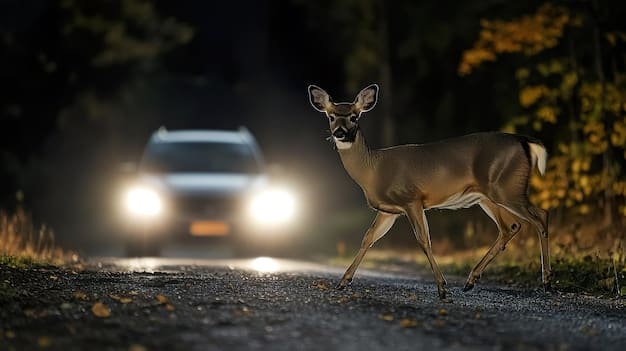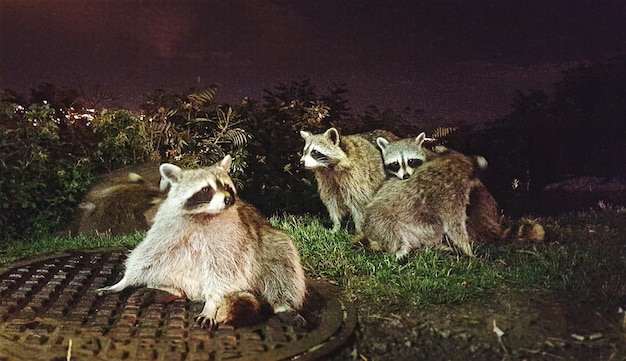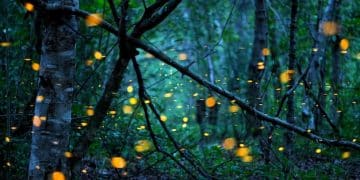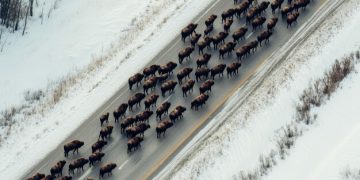Preventing Wildlife-Vehicle Collisions: Tips for US Drivers

Preventing wildlife-vehicle collisions requires drivers in the US to be vigilant, especially in areas known for wildlife crossings, by reducing speed, being aware of surroundings, and using high beams when appropriate to protect both themselves and animals.
Driving on US roads offers stunning views, but it also presents the risk of wildlife-vehicle collisions. Understanding how to prevent these incidents is crucial for the safety of both humans and animals. This article provides practical tips for drivers to minimize the risk of wildlife-vehicle collisions and protect local wildlife.
Understanding the Risks of Wildlife-Vehicle Collisions
Wildlife-vehicle collisions pose a significant threat on US roads. These incidents not only cause property damage and injuries but also result in the tragic loss of animal lives. Certain times of the year and specific locations are particularly high-risk, making it essential for drivers to be aware and prepared.
Why are Wildlife-Vehicle Collisions Common?
Several factors contribute to the frequency of wildlife-vehicle collisions. Understanding these reasons can help drivers anticipate and avoid potential incidents.
- Habitat Fragmentation: Development and road construction often fragment natural habitats, forcing animals to cross roads to find food, water, and mates.
- Seasonal Migration: During mating and migration seasons, animals are more likely to travel across roads, increasing the risk of collisions.
- Increased Traffic Volume: Higher traffic volumes mean more opportunities for collisions, especially during dawn and dusk when many animals are most active.
High-Risk Times and Locations
Knowing when and where wildlife-vehicle collisions are most likely to occur can help drivers take extra precautions. Be especially careful during these peak risk periods:
- Dawn and Dusk: Many animals, such as deer, are crepuscular, meaning they are most active during twilight hours.
- Mating Season: Deer mating season, typically in the fall, sees an increase in activity and road crossings.
- Rural Areas: Roads that run through or alongside forests, fields, and wetlands are prime locations for wildlife encounters. Pay attention to signage indicating wildlife crossing areas.

In conclusion, understanding the risks, common causes, and peak times for wildlife-vehicle collisions is the first step in preventing wildlife-vehicle collisions. By being aware of these factors, drivers can better anticipate and avoid potential hazards.
Driving Strategies for Wildlife Safety
Adopting specific driving strategies can significantly reduce the risk of wildlife-vehicle collisions. These strategies focus on increasing driver awareness, adjusting driving behavior, and using vehicle technology effectively.
Stay Alert and Scan the Road
Vigilance is key to avoiding collisions with wildlife. Drivers should actively scan the sides of the road for any signs of animal activity.
- Use Peripheral Vision: Regularly check the edges of the road for movement or reflections of eyes.
- Be Aware of Your Surroundings: Recognize that animals may appear suddenly from wooded areas or tall grasses.
- Watch for Animal Crossing Signs: Pay attention to posted signs indicating areas known for wildlife crossings and adjust your speed accordingly.
Adjust Your Speed and Braking
Speed is a major factor in wildlife-vehicle collisions. Reducing speed gives drivers more time to react and brake safely.
- Reduce Speed in High-Risk Areas: When driving through areas with known wildlife activity, reduce your speed, especially at dawn and dusk.
- Use Controlled Braking: If you spot an animal on or near the road, brake firmly but avoid sudden swerving, which can cause you to lose control.
- Maintain a Safe Following Distance: Keep a greater distance from the vehicle ahead to allow for more reaction time if an animal appears.
Using Vehicle Technology to Enhance Safety
Modern vehicle technology can play a role in preventing wildlife-vehicle collisions. These features can improve visibility and provide additional warnings.
- High Beams: When driving at night on rural roads, use high beams to increase visibility. Dim them when approaching other vehicles.
- Adaptive Cruise Control: Some vehicles have adaptive cruise control, which can help maintain a safe following distance and adjust speed automatically.
- Automatic Emergency Braking: Certain vehicles are equipped with automatic emergency braking, which can detect objects in the road and apply the brakes if the driver doesn’t react in time.
Ultimately, safe driving strategies, including vigilance, speed adjustments, and the use of vehicle technology, are essential for preventing wildlife-vehicle collisions. By implementing these measures, drivers can significantly reduce their risk and protect wildlife.
Understanding Animal Behavior to Avoid Collisions
Understanding how animals behave can help drivers anticipate their actions and avoid potential collisions. Different species exhibit different behaviors, so being aware of these patterns is crucial.
Deer Behavior
Deer are one of the most common animals involved in vehicle collisions. Their unpredictable behavior makes them particularly dangerous.
Deer often travel in groups, so if you see one cross the road, expect more to follow. They may also freeze in headlights or dart suddenly into the road. During mating season, bucks may chase does across roadways without regard for traffic. Be particularly cautious during the fall months when deer activity is at its peak.
Other Wildlife Considerations
Beyond deer, many other species can pose a risk to drivers. Understanding their behavior can help prevent collisions.
Smaller animals, like raccoons and opossums, often scavenge on roads at night. Amphibians and reptiles may bask on warm pavement, especially after rainfall. Larger animals, such as bears and moose, can also present a significant hazard due to their size and unpredictable movements. Always stay alert and adjust your driving based on the specific environment you are in.

Understanding animal behavior is paramount for preventing wildlife-vehicle collisions. By recognizing the typical actions of different species, drivers can better anticipate and respond to potential hazards, ultimately enhancing road safety for both humans and animals.
Vehicle Maintenance and Preparation
Proper vehicle maintenance is crucial for safe driving, especially in areas prone to wildlife encounters. Ensuring your vehicle is in good condition can significantly improve your ability to avoid collisions.
Importance of Regular Vehicle Checks
Regular vehicle checks can help identify and address potential issues that could compromise your safety.
Check your headlights regularly to ensure they are functioning properly. Clean headlights provide better visibility, especially at night. Make sure your brakes are in good working condition for prompt stopping. Regularly inspect tires for proper inflation and wear to maintain optimal traction. Having a well-maintained vehicle enhances your ability to react safely during wildlife encounters.
Emergency Preparedness
Preparing for emergencies can mitigate the impact of a wildlife-vehicle collision. Whether or not an accident occurs, keeping certain items in your vehicle can improve your safety.
- First Aid Kit: Include bandages, antiseptic wipes, pain relievers, and other essential medical supplies.
- Warning Devices: Keep flares, reflective triangles, or LED warning lights in your vehicle to alert other drivers in case of an emergency.
- Emergency Contact Information: Have a list of emergency contacts, including local law enforcement, animal control, and roadside assistance services.
Maintaining your vehicle and preparing for emergencies are proactive steps in preventing wildlife-vehicle collisions. By ensuring your vehicle is in optimal condition and being ready for unexpected situations, you enhance your safety and the safety of others on the road.
Community Involvement and Reporting
Community involvement plays a crucial role in preventing wildlife-vehicle collisions. Reporting incidents and supporting local conservation efforts can contribute to safer roads for both humans and animals.
Reporting Wildlife Collisions
Reporting wildlife collisions helps authorities track patterns and implement mitigation measures. Notifying the proper authorities is essential to manage the aftermath of a collision.
If you hit an animal, report the incident to local law enforcement or animal control, even if the animal runs off. Provide the location, time, and species involved, if possible. Reporting helps agencies identify high-risk areas and allocate resources for wildlife protection efforts. Additionally, it ensures that injured animals receive prompt medical attention.
Supporting Local Conservation Efforts
Community support is vital for the success of wildlife conservation initiatives. Your involvement can make a significant difference.
- Volunteer: Participate in local conservation projects, such as habitat restoration and wildlife monitoring.
- Donate: Support organizations dedicated to wildlife protection and road safety initiatives.
- Educate Others: Share information about preventing wildlife-vehicle collisions with friends, family, and community members.
By getting involved in community initiatives and reporting wildlife collisions, you contribute to a safer environment for both humans and animals. Collective action can lead to the implementation of effective strategies and ultimately reduce the frequency of these incidents.
Legislative and Infrastructure Solutions
Legislative and infrastructure solutions are critical components in preventing wildlife-vehicle collisions. Government policies and road design can significantly reduce the risk of these incidents.
Wildlife Crossing Structures
Wildlife crossing structures provide safe passages for animals to cross roads, reducing the risk of collisions. Well-designed infrastructure can protect both wildlife and drivers.
These structures include overpasses, underpasses, and culverts designed specifically for animal use. Overpasses are vegetated bridges that allow animals to cross roads without encountering traffic. Underpasses are tunnels beneath the road that provide a safe passage. Culverts are small tunnels that allow smaller animals to cross under the road while maintaining water flow. Proper placement and design of these structures are essential for their effectiveness.
Speed Limits and Enforcement
Adjusting speed limits and enforcing traffic laws in high-risk areas can significantly reduce wildlife collisions. Enforcing regulations can enhance safety.
- Reduced Speed Limits: Lower speed limits in areas known for wildlife activity give drivers more time to react.
- Nighttime Speed Limits: Implementing lower speed limits at night, when many animals are most active, can decrease collision risk.
- Traffic Enforcement: Increased traffic patrols can deter speeding and aggressive driving, especially during peak risk hours.
Legislative and infrastructure solutions are essential for long-term success in preventing wildlife-vehicle collisions. By implementing effective policies and infrastructure, communities can create safer roads for both humans and wildlife.
| Key Point | Brief Description |
|---|---|
| 🦌 Stay Alert | Always scan the road for wildlife, especially at dawn and dusk. |
| ⚠️ Reduce Speed | Lower your speed in high-risk areas to increase reaction time. |
| 💡 Use High Beams | Employ high beams on rural roads at night to improve visibility. |
| 🚧 Support Mitigation | Advocate for and support wildlife crossing structures in your community. |
Frequently Asked Questions
▼
If you spot an animal near the road, slow down immediately and be prepared to stop. Avoid sudden swerving, which can cause you to lose control of the vehicle. Use your horn to alert the animal if it’s safe to do so.
▼
Wildlife collisions are most likely to occur during dawn and dusk when many animals are most active. These twilight hours present reduced visibility, making it harder to spot animals along the roadside.
▼
To stay alert, avoid distractions like cell phones and focus on the road. Use your peripheral vision to scan the sides of the road for any movement or signs of animals. Take breaks to avoid fatigue.
▼
If you hit an animal, pull over to a safe location and assess the situation. Report the incident to local law enforcement or animal control. Do not approach the animal, as it may be injured and dangerous.
▼
Yes, some vehicles are equipped with technologies like adaptive cruise control and automatic emergency braking, which can help prevent collisions. High beams also enhance visibility at night, aiding in spotting animals from a distance.
Conclusion
Preventing wildlife-vehicle collisions requires a multifaceted approach involving driver awareness, vehicle maintenance, community involvement, and infrastructure solutions. By implementing these strategies, we can create safer roads for both humans and animals.





